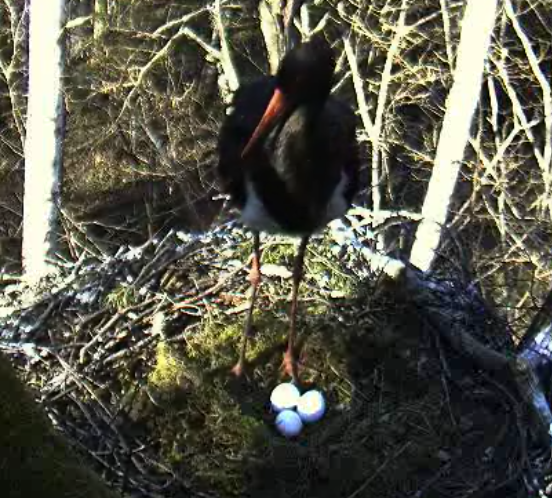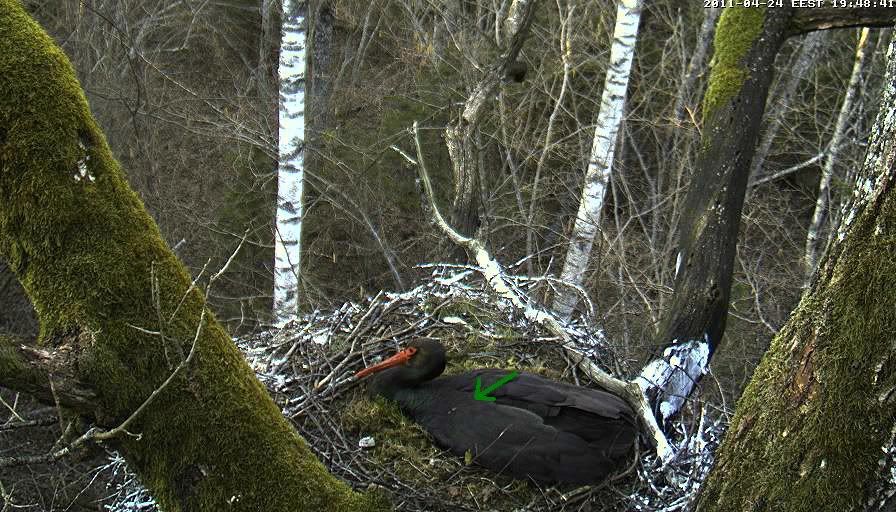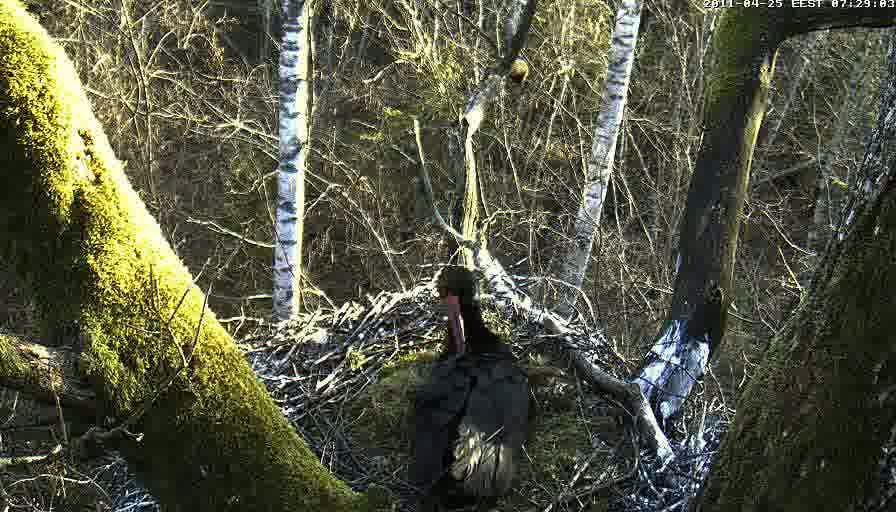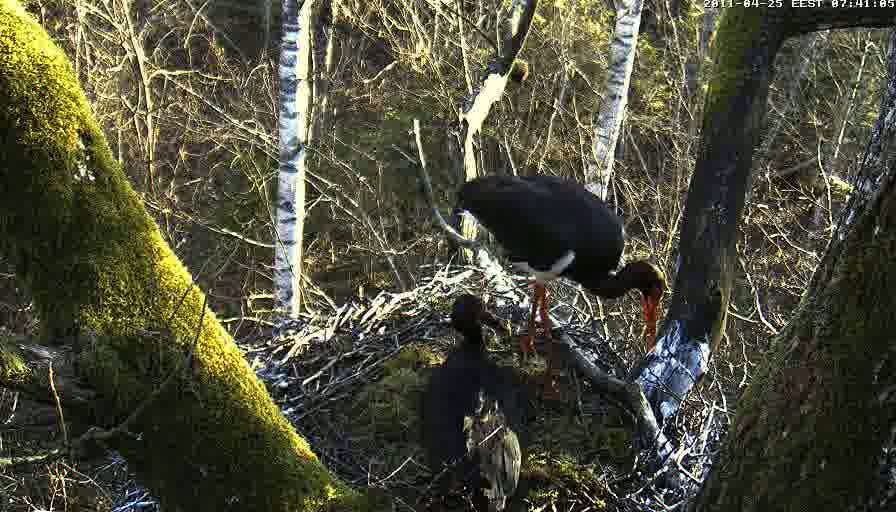Black Stork Webcam - Tiit & Tiina 2011
- Bairbre
- Registered user
- Posts: 523
- Joined: November 15th, 2008, 4:21 pm
- Location: Toronto Canada
Re: Black Stork Webcam - New Nest.
Good Morning, Happy Easter Everyone!
Proud member of SHoW. (StorkaHolics Of the World)
"There are no strangers here; only friends you haven't met yet"
William Butler Yeats
"There are no strangers here; only friends you haven't met yet"
William Butler Yeats
-
Jo UK
- Site Admin
- Posts: 20709
- Joined: September 20th, 2008, 1:40 am
- Location: Winchester, UK
Good morning, Bairbre.
Happy Easter to you and to everyone here.
Happy Easter to you and to everyone here.
- Olga
- Registered user
- Posts: 9111
- Joined: October 11th, 2008, 2:48 pm
- Location: Finland
I didn't see those spots, but there are they, right.rachowiak wrote: In my opinion it's Tiina. I compared your pictures with my yesterday's graphics. I think important feature is the shape of patches of black feathers at the base of the lower half of the bill. Please note the three bright spots visible on the left wing (fourth photo).
Some pics from afternoon before 16:00, it's Tiina! I saw several time the spots on the left shoulder (wing..how to say), but then she aired her feathers, and I concentrate to catch her eyes from right and left.





SHoW(StorkaHolics of the World)
-
Jo UK
- Site Admin
- Posts: 20709
- Joined: September 20th, 2008, 1:40 am
- Location: Winchester, UK
Reminder of the waiting time to come
http://www.oiseaux-birds.com/article-st ... white.html
STORKS IN BLACK AND WHITE
Black Stork and White Stork belong to the Order Ciconiiformes, Family Ciconiidae, and Genus Ciconia.
We would be tempted to say they are very similar, but if the appearance is almost the same except the plumage, these beautiful birds have their own habits and behaviours.
Both species show three main colours such as black, white and red.
In White Stork, the pure white head, neck, underparts, tail and mantel contrast strongly with the black primary and secondary flight feathers. The long bill and legs are red. The eyes are brown to grey.
The juvenile is duller than adults and the bare parts are pinkish-grey to grey.
White Stork is slightly larger than Black Stork.
All these symbols made these birds very well protected, whereas numerous large birds were persecuted.
However, declines regularly occur, and we have to care these beautiful birds if we wish to see them in the sky for long time.
Photographs of Black Stork at nest by Steve Garvie
RAINBIRDER Photo galleries
Text and photographs by Nicole Bouglouan
Sources :
HANDBOOK OF THE BIRDS OF THE WORLD vol 1 by Josep del Hoyo-Andrew Elliot-Jordi Sargatal -
The Black Stork has black plumage showing green and purple gloss. Lower breast, belly, vent and thighs are white. The bare parts, bill, legs and broad eye-ring are red.
The juvenile is duller and brownish, with greenish-grey bare parts.
Both storks hunt by walking slowly, watching for preys. When the prey is detected by sight, they snatch it up with the long bill.
White Stork feeds in drier areas than Black Stork which often hunts in shallow water, but both need wet areas for feeding. Black Stork feeds mainly on fish whereas White Stork prefers small mammals.
Their usual preys include fish, amphibians, reptiles, small mammals, large insects, and whatever kind of available food.
The White Stork mainly frequents open areas and wetlands. This species is more terrestrial in Africa where the most part of the population winters. At this period, it is found in steppes and savannahs, grasslands, cultivated areas with pools, marshes and slow streams, lakesides, all with scattered trees for nesting.
This bird is strongly migratory, spending the winter in Tropical and South Africa and in India (Subspecies Ciconia ciconia asiatica).
They breed in the warm parts of Europe, in North-west Africa and South-west India. Since several years, numerous breeding pairs remain in their breeding range all year round, according to the food resources and weather conditions. The young birds migrate.
The Black Stork frequents more undisturbed open woodlands than wide open areas. It feeds in wet areas such as streams, pools, marshes and sometimes grasslands. This species avoids large rivers and dense forests.
The Black Stork is also a migratory species, with partially resident population in Spain.
They winter in Tropical Africa.
The South-African populations perform post-breeding dispersions, and mainly altitudinal movements.
Other populations winter from W Pakistan, through N India to SE and E China.
This species breeds across Palearctic, and we can find some local populations in Africa, from Malawi and Namibia to South Africa.
At the beginning of the breeding season, the White Stork male arrives first and waits for the female. It arranges or builds a new nest, helped later by the female.
White Stork nests in loose colonies, in trees, buildings, pylons, human structures or cliffs. The nest is reused year after year and may become huge. It is made with sticks, and lined with several kinds of items such as dung, paper, moss, grasses, plastics and debris.
Strong fights may occur between males at this moment, if other male tries to appropriate the nest.
Then, it is time for courtship displays. Male throws its head backwards, on shoulders, fans its tail, with rump raised at back level, with continuous wing beats. Sometimes, female joins it in this display. These displays, although less obvious, continue during the laying period and are often observed at nest.
In March-April, female lays three or four eggs and the incubation lasts about 34 days. The young fledge two months later and are sexually mature at four years.They are fed by both parents with regurgitated food into the nest. After leaving the nest, the young birds fly with adults and return to the nest for sleeping and feeding.
This species produces one brood per year.
Adult bringing water to the young at nest. The Black Stork breeds in spring. It is a solitary nester and usually nests in trees in forests, but according to the range, this species may also nest on cliff ledges, always near water.
The large nest is made with sticks and lined with leaves, moss and grasses cemented with earth. It is reused year after year.
Courtship displays occur in late March. The Black Stork performs less elaborated courtship rituals than White Stork, with fanned tail and undulating neck. Both mates also perform flight displays.
Later, female lays three or four eggs. Incubation lasts about 32 to 38 days, sometimes more. Young fledge 63 to 70 days later, and are sexually mature at three years. They are fed by both parents with regurgitated food into the nest.
Black Stork produces one brood per year.
http://www.oiseaux-birds.com/article-st ... white.html
STORKS IN BLACK AND WHITE
Black Stork and White Stork belong to the Order Ciconiiformes, Family Ciconiidae, and Genus Ciconia.
We would be tempted to say they are very similar, but if the appearance is almost the same except the plumage, these beautiful birds have their own habits and behaviours.
Both species show three main colours such as black, white and red.
In White Stork, the pure white head, neck, underparts, tail and mantel contrast strongly with the black primary and secondary flight feathers. The long bill and legs are red. The eyes are brown to grey.
The juvenile is duller than adults and the bare parts are pinkish-grey to grey.
White Stork is slightly larger than Black Stork.
All these symbols made these birds very well protected, whereas numerous large birds were persecuted.
However, declines regularly occur, and we have to care these beautiful birds if we wish to see them in the sky for long time.
Photographs of Black Stork at nest by Steve Garvie
RAINBIRDER Photo galleries
Text and photographs by Nicole Bouglouan
Sources :
HANDBOOK OF THE BIRDS OF THE WORLD vol 1 by Josep del Hoyo-Andrew Elliot-Jordi Sargatal -
The Black Stork has black plumage showing green and purple gloss. Lower breast, belly, vent and thighs are white. The bare parts, bill, legs and broad eye-ring are red.
The juvenile is duller and brownish, with greenish-grey bare parts.
Both storks hunt by walking slowly, watching for preys. When the prey is detected by sight, they snatch it up with the long bill.
White Stork feeds in drier areas than Black Stork which often hunts in shallow water, but both need wet areas for feeding. Black Stork feeds mainly on fish whereas White Stork prefers small mammals.
Their usual preys include fish, amphibians, reptiles, small mammals, large insects, and whatever kind of available food.
The White Stork mainly frequents open areas and wetlands. This species is more terrestrial in Africa where the most part of the population winters. At this period, it is found in steppes and savannahs, grasslands, cultivated areas with pools, marshes and slow streams, lakesides, all with scattered trees for nesting.
This bird is strongly migratory, spending the winter in Tropical and South Africa and in India (Subspecies Ciconia ciconia asiatica).
They breed in the warm parts of Europe, in North-west Africa and South-west India. Since several years, numerous breeding pairs remain in their breeding range all year round, according to the food resources and weather conditions. The young birds migrate.
The Black Stork frequents more undisturbed open woodlands than wide open areas. It feeds in wet areas such as streams, pools, marshes and sometimes grasslands. This species avoids large rivers and dense forests.
The Black Stork is also a migratory species, with partially resident population in Spain.
They winter in Tropical Africa.
The South-African populations perform post-breeding dispersions, and mainly altitudinal movements.
Other populations winter from W Pakistan, through N India to SE and E China.
This species breeds across Palearctic, and we can find some local populations in Africa, from Malawi and Namibia to South Africa.
At the beginning of the breeding season, the White Stork male arrives first and waits for the female. It arranges or builds a new nest, helped later by the female.
White Stork nests in loose colonies, in trees, buildings, pylons, human structures or cliffs. The nest is reused year after year and may become huge. It is made with sticks, and lined with several kinds of items such as dung, paper, moss, grasses, plastics and debris.
Strong fights may occur between males at this moment, if other male tries to appropriate the nest.
Then, it is time for courtship displays. Male throws its head backwards, on shoulders, fans its tail, with rump raised at back level, with continuous wing beats. Sometimes, female joins it in this display. These displays, although less obvious, continue during the laying period and are often observed at nest.
In March-April, female lays three or four eggs and the incubation lasts about 34 days. The young fledge two months later and are sexually mature at four years.They are fed by both parents with regurgitated food into the nest. After leaving the nest, the young birds fly with adults and return to the nest for sleeping and feeding.
This species produces one brood per year.
Adult bringing water to the young at nest. The Black Stork breeds in spring. It is a solitary nester and usually nests in trees in forests, but according to the range, this species may also nest on cliff ledges, always near water.
The large nest is made with sticks and lined with leaves, moss and grasses cemented with earth. It is reused year after year.
Courtship displays occur in late March. The Black Stork performs less elaborated courtship rituals than White Stork, with fanned tail and undulating neck. Both mates also perform flight displays.
Later, female lays three or four eggs. Incubation lasts about 32 to 38 days, sometimes more. Young fledge 63 to 70 days later, and are sexually mature at three years. They are fed by both parents with regurgitated food into the nest.
Black Stork produces one brood per year.
- Bairbre
- Registered user
- Posts: 523
- Joined: November 15th, 2008, 4:21 pm
- Location: Toronto Canada
Thank you Jo!
Proud member of SHoW. (StorkaHolics Of the World)
"There are no strangers here; only friends you haven't met yet"
William Butler Yeats
"There are no strangers here; only friends you haven't met yet"
William Butler Yeats
-
Jo UK
- Site Admin
- Posts: 20709
- Joined: September 20th, 2008, 1:40 am
- Location: Winchester, UK
It was rather longer than I intended, but it is all good information.
-
Jo UK
- Site Admin
- Posts: 20709
- Joined: September 20th, 2008, 1:40 am
- Location: Winchester, UK
17.54
Tiina left.
Tiit on eggs.
Tiina left.
Tiit on eggs.
- Lussi05
- Registered user
- Posts: 10043
- Joined: April 21st, 2011, 8:10 pm
- Location: Norway

Hello, is it Tiit in the nest? I do not have the experienceto see the difference
-
Jo UK
- Site Admin
- Posts: 20709
- Joined: September 20th, 2008, 1:40 am
- Location: Winchester, UK
It was Tiit who came to the nest at the time of my last post. I haven't watched constantly since then, and I can't see the beak of the sitting bird now. That's all I know.
- Bubo
- Registered user
- Posts: 1832
- Joined: April 18th, 2011, 12:46 pm
Hello!
Now at nest Tiina because there are white spots on left

Now at nest Tiina because there are white spots on left

Bubo Bubo
- macdoum
- Registered user
- Posts: 6786
- Joined: November 17th, 2008, 12:12 am
- Location: Alsace, France
Carmel a member of SHOW .. I hope you love birds too. Its economical. It saves going to heaven.
Emily Dickinson
Emily Dickinson
- Olga
- Registered user
- Posts: 9111
- Joined: October 11th, 2008, 2:48 pm
- Location: Finland
- NancyM
- Site Admin
- Posts: 5690
- Joined: October 14th, 2008, 6:20 pm
- Location: Boston, Massachusetts, USA
Monday, April 25
5:15 in the morning (added: and exactly the same at 5:45 !)

estonia_black stork_nest 2_515_25April2011 by aurospio, on Flickr
5:15 in the morning (added: and exactly the same at 5:45 !)

estonia_black stork_nest 2_515_25April2011 by aurospio, on Flickr
- juta
- Site Admin
- Posts: 5732
- Joined: September 25th, 2008, 1:52 pm
- Location: Tallinn, Estonia
Good morning!
No surprises - 3 eggs.
No surprises - 3 eggs.
Proud member of SHoW (StorkaHolics of the World)
-
Urmas
- Registered user
- Posts: 1303
- Joined: October 27th, 2008, 7:44 am
- Location: Estonia
Did anybody see, if something happened before the signal disappeared?
- ame
- Moderator
- Posts: 77183
- Joined: April 7th, 2009, 10:26 pm
- Location: Turku, Finland
- Contact:
no. i looked at about 8.30 and the screen was white, saying "too many retries, give up!"
-
Urmas
- Registered user
- Posts: 1303
- Joined: October 27th, 2008, 7:44 am
- Location: Estonia
About 7:45 it was still working, but then I needed to left for a hour...
- ame
- Moderator
- Posts: 77183
- Joined: April 7th, 2009, 10:26 pm
- Location: Turku, Finland
- Contact:
correction: it must have been later when i looked, at about ten to 9, 8.50.
- Felis silvestris
- Site Admin
- Posts: 20038
- Joined: February 20th, 2011, 4:54 pm
- Location: Germany
What a bad surprise 
I made my first picture around 7.30 in the morning

still in bed, with my small netbook
and the third one around 7.42 and just after that it went off and did not come back

I just can hope it's something with the transmission which can be fixed and not with the cam near the nest, otherwise for us the season is already over before it began
I made my first picture around 7.30 in the morning

still in bed, with my small netbook
and the third one around 7.42 and just after that it went off and did not come back

I just can hope it's something with the transmission which can be fixed and not with the cam near the nest, otherwise for us the season is already over before it began
“One can measure the greatness and the moral progress of a nation by looking at how it treats its animals” (Mahatma Gandhi)
"You can judge a man's true character by the way he treats his fellow animals" (Paul McCartney)
The Aquila Pomarina Collection
"You can judge a man's true character by the way he treats his fellow animals" (Paul McCartney)
The Aquila Pomarina Collection
- jopie
- Registered user
- Posts: 5990
- Joined: November 30th, 2009, 2:22 pm
- Location: the Netherlands

